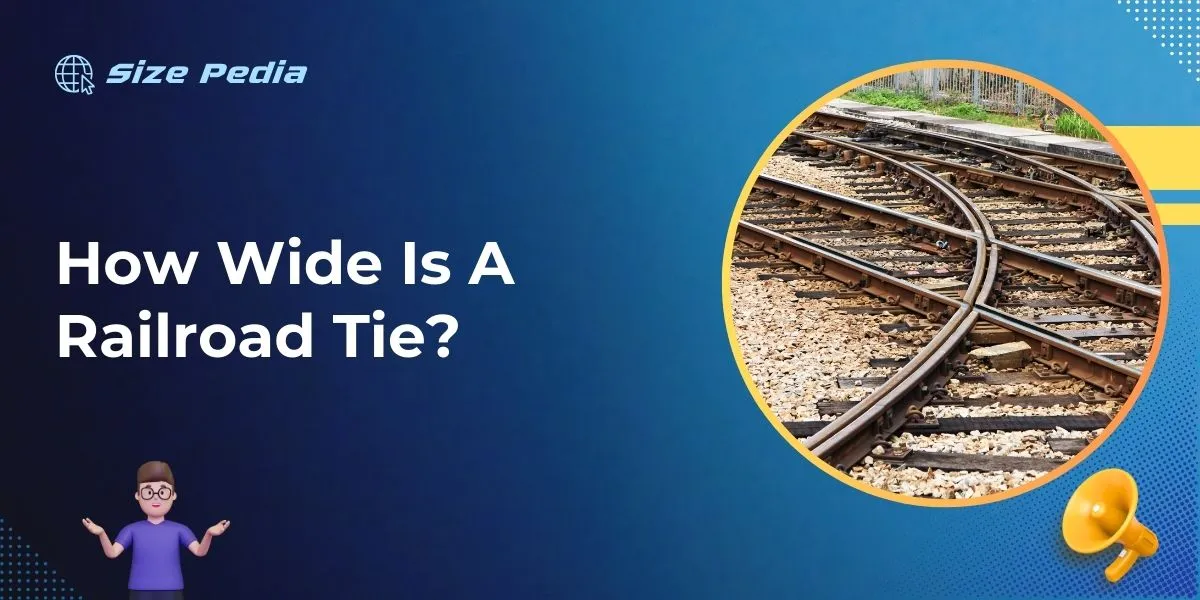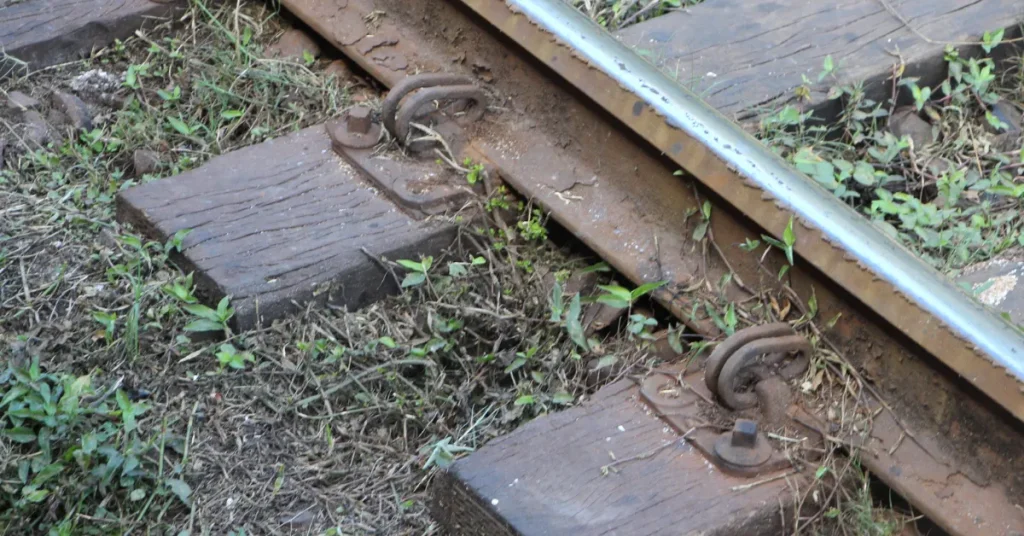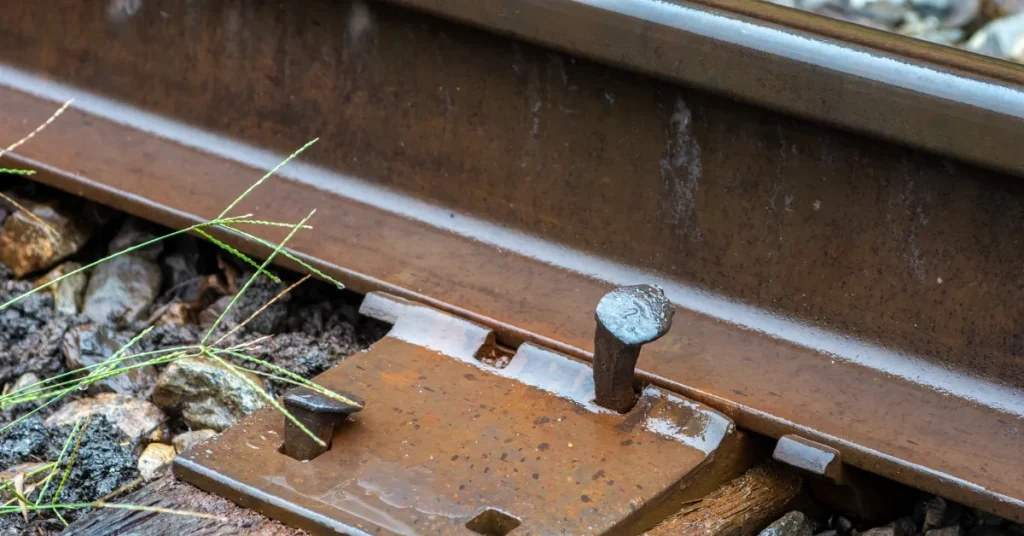A standard railroad tie is typically 9 inches wide. This size allows for stable tracks and secure placement of rails.
Railroad ties, the rectangular supports laid perpendicular to the rails on a railway track, are crucial for track integrity. These wooden or concrete beams have a uniform width to ensure the rails remain parallel, providing a reliable pathway for trains.
The dimensions of railroad ties play an essential role in maintaining the gauge of the track, which is the distance between the inner sides of the two parallel rails.
This exacting width allows for an even distribution of weight and a smooth ride for trains. Understanding the width and other dimensions of railroad ties is essential for those interested in railroad construction, maintenance and model train setups.

The Basics Of Railroad Ties
Railroad ties, also known as sleepers, are a fundamental component in rail construction. These sturdy blocks support the tracks and maintain the alignment of rails.
Understanding their size and material is crucial for those working in transportation, construction, or landscaping projects.
Standard Measurements
The size of railroad ties has been standardized to ensure safety and stability across miles of track.
The standard dimensions for a railroad tie in North America are about 7 inches wide, 9 inches tall, and 8.5 feet long. These measurements apply to both new and repurposed ties used for various projects.
| Dimension | Measurement (inches) | Measurement (feet) |
| Width | 7 | – |
| Height | 9 | – |
| Length | 102 (approx.) | 8.5 |
Materials And Durability
Railroad ties come in different materials, each offering unique strengths. The most common material is wood, particularly hardwood like oak due to its natural durability. Other materials include concrete and plastic composites.
These materials are chosen for their ability to withstand heavy loads and harsh weather conditions over time.
- Wooden ties: Traditional, durable, treated with preservatives.
- Concrete ties: Stronger than wood, low-maintenance, long lifespan.
- Plastic composite ties: Eco-friendly, resistant to rot and pests.
When selecting a railroad tie, consider both the material and expected lifespan. Wooden ties can last up to 30 years, while concrete and composite options offer even more durability, often exceeding 50 years of service.
Variations Across Countries
Did you know that a railroad tie’s width can vary depending on where you are in the world? These wooden or concrete beams, also known as railway sleepers, provide a sturdy base for tracks. Let’s explore how their sizes change from continent to continent.
Differences In North America
Railroad ties in North America are known for their robust build. Typically made from wood like oak, they have a standard width. The standard size for a North American tie is 7 inches wide, though the width can vary slightly. Here’s a snapshot:
| Type | Width |
| Standard Tie | 7 inches |
| Industrial Tracks | 9 to 10 inches |
European Standards
In Europe, railway ties are generally narrower. Their width rests mainly at 6 to 6.5 inches. This width helps to support the different rail systems across the continent. Europe prefers prestressed concrete ties, which are more uniform in shape and size.
Asia And The Rest Of The World
Asian countries, much like Europe, often use narrower ties for their railway systems. Widths can vary greatly, though, due to the different rail gauges present.
Countries such as Japan and China have advanced rail networks and thus more standardization in their tie dimensions.
African and South American ties range widely in size, influenced by historic European colonization and current economic resources.
- Japan: 6.2 inches
- China: 6.7 inches
In summary, while the width of a railroad tie is an important detail in the infrastructure of railway systems, it varies considerably around the globe. Such differences reflect the unique engineering standards and geographic needs of each country.
Understanding Railroad Tie Dimensions

Railroad ties are vital components for railway infrastructure. They provide stability for rails and ensure safe train travel. Typical railroad ties are wooden, but concrete and steel ties are also common.
Knowing their dimensions aids in maintenance, landscape design, and upcycling projects. Let’s explore these dimensions in closer detail.
Width
Railroad ties have a standard width. This width supports the weight of trains. The average width lies at approximately 9 inches across.
Length
The length of a railroad tie enables stability for the tracks. Standard ties measure about 8 to 10 feet long. This length supports multiple rail types and gauge widths.
Thickness
Thickness contributes to a tie’s durability. Most railroad ties boast a thickness between 7 and 8 inches. This thickness withstands substantial weights and weather variances.
Why Dimensions Matter
Railroad tie dimensions impact numerous factors:
- Safety: Correct dimensions prevent track misalignments and accidents.
- Lifespan: Adequate sizing ensures long-lasting support for rail tracks.
- Compatibility: Ties must fit specific rail systems and gauges.
Consistent dimension checks are crucial for railroad safety and functionality. Incorrect measurements can lead to derailments or infrastructure failure. Architects and landscapers may also utilize these dimensions in design projects.
Impact Of Dimensions On Rail Safety
Railroad ties, known as sleepers, are critical for rail stability and safety. Their dimensions have a direct impact on the railway’s ability to carry loads and withstand the passage of trains.
A standard railroad tie’s width contributes to the track’s overall strength and durability.
The Importance Of Stability
Railway ties provide a stable base for the rails. Incorrect dimensions can lead to track instability and pose serious safety risks. Properly sized ties distribute the weight of passing trains evenly, minimizing track deformation.
The standard width for railroad ties in the U.S. typically ranges from 9 to 10 inches, ensuring that rails remain parallel and secure.
- Even weight distribution prevents track bending.
- Width supports effective rail alignment.
Maintenance And Lifespan Of Ties
Dimensions also affect a tie’s resistance to wear and ease of maintenance. Wider ties tend to last longer, as they provide a more substantial support base for the rails. Regular checks and replacements are crucial to maintain track safety.
The tie’s lifespan varies based on material and environmental conditions but ensuring they are within the standard width specifications is essential for long-term reliability.
| Material | Average Lifespan |
| Wooden | 20-30 years |
| Concrete | 30-50 years |
| Steel | 20-30 years |
Properly maintained ties ensure track integrity and passenger safety. A track without adequately sized ties would be vulnerable to structural failures.
Future Of Railroad Ties

The future of railroad ties looks ripe for innovation. As we forge ahead, changes in materials and design are inevitable. These changes aim to enhance durability, sustainability, and compatibility with modern rail systems.
Innovations In Materials
Materials used in railroad ties are advancing. Strong, sustainable choices are key. Companies explore:
- Recycled plastics to reduce waste,
- Composite materials for longer life,
- Eco-friendly preservatives for wood ties.
New materials must withstand heavy loads. They must handle harsh weather too.
Evolving Design Standards
Railroad tie design standards are also changing. The goal is to support faster and heavier trains. Key factors include:
- Dimensions: Sizes may vary to better support tracks,
- Modularity: Easy to replace pieces keep tracks safe,
- Integration: Ties that work with advanced monitoring tech.
Standard updates will lead to smarter and safer railroads. Future designs consider global rail traffic growth.
FAQs About How Wide Is A Railroad Tie
What Is The Standard Size Of A Railroad Tie?
The standard size of a railroad tie is approximately 7 inches by 9 inches and usually 8. 5 feet long.
Why Are Railroad Ties Illegal?
Railroad ties are often considered illegal to use in landscaping or construction because they can contain harmful chemicals, such as creosote, which is toxic and can leach into the soil, posing environmental and health hazards.
How Heavy Is An 8 Foot Railroad Tie?
An 8-foot railroad tie typically weighs between 200 and 300 pounds, depending on the wood type and condition.
How Much Does A 12 Foot Railroad Tie Weigh?
A standard 12-foot railroad tie typically weighs around 200-300 pounds, depending on the type of wood and its condition.
Conclusion
Understanding the standard width of a railroad tie can enhance your appreciation for railway construction.
Typically, ties are about 9 inches wide, a measurement vital for stability and safety. Remember, the right width ensures trains travel smoothly across miles of track.
Embrace this knowledge on your next rail journey or project.
Resources:
1. https://www.transportation.gov/utc/energy-harvesting-railroad-tie-improving-track-condition-monitoring-and-safety
